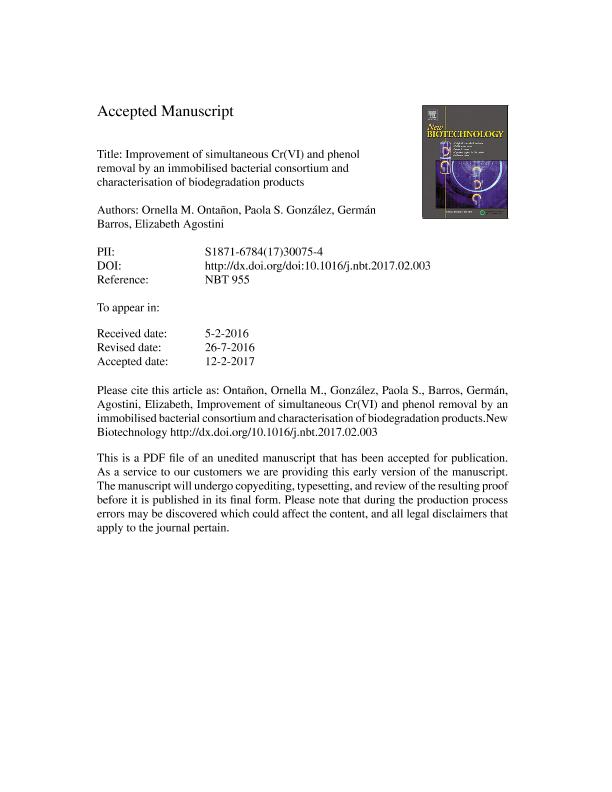Mostrar el registro sencillo del ítem
dc.contributor.author
Ontañon, Ornella Mailén

dc.contributor.author
González, Paola Solange

dc.contributor.author
Barros, Germán Gustavo

dc.contributor.author
Agostini, Elizabeth

dc.date.available
2018-04-05T16:01:06Z
dc.date.issued
2017-07
dc.identifier.citation
Ontañon, Ornella Mailén; González, Paola Solange; Barros, Germán Gustavo; Agostini, Elizabeth; Improvement of simultaneous Cr(VI) and phenol removal by an immobilised bacterial consortium and characterisation of biodegradation products; Elsevier Science; New Biotechnology; 37; Part B; 7-2017; 172-179
dc.identifier.issn
1871-6784
dc.identifier.uri
http://hdl.handle.net/11336/40876
dc.description.abstract
Microbial bioremediation emerged some decades ago as an eco-friendly technology to restore polluted sites. Traditionally, the search for microorganisms suitable for bioremediation has been based on the selection of isolated strains able to remove a specific type of pollutant. However, this strategy has now become obsolete, since co-pollution is a global reality. Thus, current studies attempt to find bacterial cultures capable of coping with a mixture of organic and inorganic compounds. In this sense, the bacterial consortium SFC 500-1 has demonstrated efficiency for Cr(VI) and phenol removal, both of which are found in many industrial wastewaters. In the present study, the ability of SFC 500-1 for simultaneous removal was improved through its entrapment in a Ca-alginate matrix. This strategy led to an increased removal of Cr(VI), which was partially reduced to Cr(III). Immobilised cells were able to tolerate and degrade phenol up to 1,500 mg/l at high rates, forming catechol and cis,cis-muconate as oxidation intermediates. Successful removal potential through 5 cycles of reuse, as well as after long-term storage, was another important advantage of the immobilised consortium. These characteristics make SFC 500-1 an interesting system for potential application in the biotreatment of co-polluted effluents.
dc.format
application/pdf
dc.language.iso
eng
dc.publisher
Elsevier Science

dc.rights
info:eu-repo/semantics/embargoedAccess
dc.rights.uri
https://creativecommons.org/licenses/by-nc-nd/2.5/ar/
dc.subject
Alginate Beads
dc.subject
Chromium(Vi)
dc.subject
Immobilisation
dc.subject
Phenol
dc.subject
Simultaneous Removal
dc.subject.classification
Otras Ciencias Biológicas

dc.subject.classification
Ciencias Biológicas

dc.subject.classification
CIENCIAS NATURALES Y EXACTAS

dc.title
Improvement of simultaneous Cr(VI) and phenol removal by an immobilised bacterial consortium and characterisation of biodegradation products
dc.type
info:eu-repo/semantics/article
dc.type
info:ar-repo/semantics/artículo
dc.type
info:eu-repo/semantics/publishedVersion
dc.date.updated
2018-04-05T13:42:15Z
dc.journal.volume
37
dc.journal.number
Part B
dc.journal.pagination
172-179
dc.journal.pais
Países Bajos

dc.journal.ciudad
Amsterdam
dc.description.fil
Fil: Ontañon, Ornella Mailén. Universidad Nacional de Río Cuarto. Facultad de Ciencias Exactas Fisicoquímicas y Naturales; Argentina. Consejo Nacional de Investigaciones Científicas y Técnicas; Argentina
dc.description.fil
Fil: González, Paola Solange. Universidad Nacional de Río Cuarto. Facultad de Ciencias Exactas Fisicoquímicas y Naturales; Argentina. Consejo Nacional de Investigaciones Científicas y Técnicas; Argentina
dc.description.fil
Fil: Barros, Germán Gustavo. Universidad Nacional de Río Cuarto. Facultad de Ciencias Exactas Fisicoquímicas y Naturales; Argentina. Consejo Nacional de Investigaciones Científicas y Técnicas; Argentina
dc.description.fil
Fil: Agostini, Elizabeth. Universidad Nacional de Río Cuarto. Facultad de Ciencias Exactas Fisicoquímicas y Naturales; Argentina. Consejo Nacional de Investigaciones Científicas y Técnicas; Argentina
dc.journal.title
New Biotechnology

dc.rights.embargoDate
2018-07-01
dc.relation.alternativeid
info:eu-repo/semantics/altIdentifier/doi/http://dx.doi.org/10.1016/j.nbt.2017.02.003
dc.relation.alternativeid
info:eu-repo/semantics/altIdentifier/url/https://www.sciencedirect.com/science/article/pii/S1871678417300754
Archivos asociados
